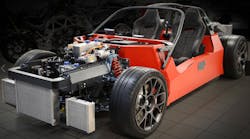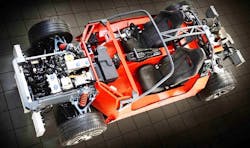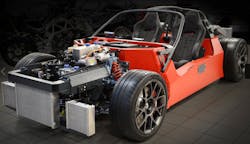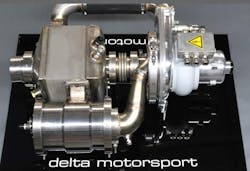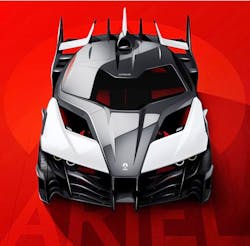Would you want a four-wheel-drive EV that gets up to 60 mph in 2.4 seconds, to 100 mph in just 3.8 seconds, and has a 160-mph top speed? If the answer is yes, you’ll have to wait until 2020 when the full-body version goes into production. Now, it is only in the prototype stage. Plus, you’ll have to go to Somerset, England, to pick one up from the Ariel Motor Company. Another thing: Ariel will use a micro turbine generator to recharge the battery and extend the vehicle’s driving range.
The company released some details of its all-new, ultra-high performance, range-extended, electric sports car project currently labeled HIPERCAR, an acronym for HIgh PERformance CArbon Reduction. The company has not yet decided on a name for the vehicle. Ariel Director Simon Saunders says, “This is the first true electric supercar that will cross continents, drive to town, and lap a race track.”
HIPERCAR will be available as a four-wheel or two-wheel rear drive, full-bodied car, the final exterior design of which is to be released at a later date. Based around an aluminum folded and bonded lightweight chassis with full rollover protection, the structure features aluminum front and rear sub-frames carrying aluminum wishbones and outboard adjustable suspension. The HIPERCAR’s suspension will feature double wishbones at all four corners with dampers supplied by Bilstein. Ariel is developing a power steering system to provide the ultimate feedback to the driver. Forged or carbon composite wheels carry 265/35/R20 front and 325/30/R21 rear tires.
HIPERCAR will be available as a four-wheel or two-wheel rear drive, full-bodied car, the final exterior design of which is to be released at a later date. The photos above show the prototype.
There are two motors, one at each rear wheel for rear drive, or four electric motors, one at each wheel for all-wheel drive. Powered wheels are driven by inboard motors via integral, single-speed step-down gearboxes direct to driven wheels, with each individual motor developing 220kW (295bhp) and 450Nm (332 ft.-lb) of torque. The entire motor, gearbox, and inverter assembly weighs only 126 lb. The table below lists the torque and power for the four-wheel and two-wheel drives.
Total torque and power at motors and wheels
The vehicle’s electrical architecture consists of high- and low-voltage systems linked by multiple CAN networks enabling the Powertrain Controller, Vehicle Dynamic Control Interface, and Battery Controller to communicate and interact with 12V safety systems.
This hybrid EV features a 750 V, 42 kWh, or 56kWh, lithium-ion, cooled and heated battery pack, which you can charge, when required, by a 35kW micro-turbine range extender, meaning the car can run from fuel available at your local gas station. This negates any range anxiety issues and makes the vehicle independent of any charging infrastructure.
Range Extender
The MITRE (MIcro-Turbine Range Extender) from Delta Motorsport will be used by the HIPERCAR. The benefits of the MITRE are that it is much lighter, smaller, and more efficient than conventional gasoline engines in cars, though they tend to produce very high temperature exhaust that might be difficult to manage.
The MITRE prototype system comes in two power outputs, 23bhp and 47bhp, and is about 40% smaller and, at 50kg, about 50% lighter than an equivalent piston engine. The more powerful unit also has a thermal efficiency of about 30%, which matches the best piston engines, and both versions have very low emission outputs. Delta says adding a larger heat exchanger can improve the unit’s thermal efficiency to 35%, which ranks the unit alongside high-performance racing engines.
The MITRE prototype system comes in two power outputs, 23bhp and 47bhp, and is about 40% smaller and, at 50kg, about 50% lighter than an equivalent piston engine.
Delta engineering director Nick Carpenter believes turbine engines are the most efficient answer to improving EV range. “There have been various attempts to introduce turbine engines into passenger cars, but those engines were directly driving the wheels,” he says. “Electric vehicle sales are gaining traction now, but people who travel long distances still need more range, and this is where the range extender still provides the best answer,”
Carpenter said adding more batteries to a car to increase its range has its limits due to the weight of battery cells, but a turbine range extender can drastically increase an EV’s range for a tiny offset of emissions.
To keep costs down, Delta has avoided using exotic materials. “There were many fundamental decisions made in the early stages of the program that have ensured we’re keeping the production costs down,” says Carpenter. “About 90% of the cost comes from production, so there’s lots of opportunity to bring the price down once production picks up.”
Carpenter said production makes up 10% of battery costs, meaning it’s the physical materials that make up 90% of costs. It’s for this reason he believes range extenders are the cost-effective answer for now. “I think there’ll always be a place for range extenders,” says Carpenter. “Even if the technology takes off and we have batteries that can offer 150 miles of motorway driving, it still won’t be enough for long-distance drivers.”
Carpenter believes that the mainstream manufacturers have been slow to take to electric, and makers of fully electric cars, such as Tesla, have limited their market to people who can run EVs. He says that range extenders, however, are the best of both worlds.
Above, a rendering of a possible full-bodied HIPERCAR.
The turbine technology has been created in a £3.1 million collaborative research and development project that’s been co-funded by the UK Office for Low Emission Vehicles (OLEV) and Innovate UK.
One question remains: Will the production version in 2020 provide the same characteristics as the present prototype vehicle?
